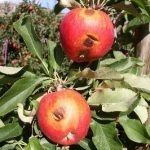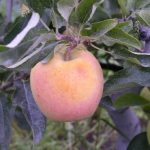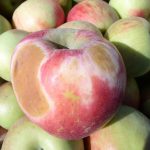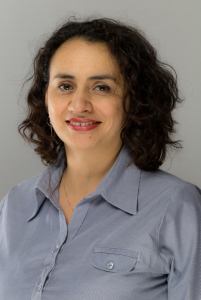Written by Jenny L. Bolivar-Medina, ITT WSU Extension, and Lee Kalcsits, Endowed Chair WSU Horticulture. August 2021. Reviewed July, 2022.
What is sunburn?
Sunburn is a physiological disorder caused by the exposure of the fruit to excessive high solar radiation and temperatures. It is irreversible and can cause more than 10% of losses in WA State. Some cultivars like Honeycrisp are more susceptible to sunburn. Low wind speed and humidity also contribute to the susceptibility to sunburn under high light and temperature conditions. In general, air temperatures above 90 °F is when sunburn risk substantially increases and when sunburn mitigation plans need to be implemented. Under extreme conditions that were present at the end of June (air temperatures exceeded 100 °F from 10:30 am to sunset for four days), multiple sunburn mitigation practices should be used.
What are the risks?
Depending on the factor or set of factors that caused sunburn, there are three types of sunburn that have been characterized and are summarized in Table 1.
Table 1: Sunburn type and characteristics
| Type of sunburn | Involved factor(s) | Characteristics | Example |
|---|---|---|---|
| Sunburn Necrosis | High fruit surface temperature (FST): 52°C (125°F) for at least 10 minutes | Fruit with dark brown or black necrotic spots, as the result of cellular death.
Damage can be observed within 1 to 4 days after heat exposure. |
 |
| Sunburn Browning | High solar radiation and high FST for at least 60 minutes.
High FST is cultivar dependent and can start at 46°C (115°F). |
Fruit with yellow, brown bronze or dark tan spots on the surface exposed to sun. | Rotator Image of Sunburn Browning
 |
| Photooxidative Sunburn | Sudden exposure of shaded fruit surface to full sunlight without prior acclimation. Produced by thinning, pruning, shifting of branches, etc. | Temperatures as low as 31°C (88°F) can cause white spots (bleaching) in areas of the fruit’s skin that were previously shaded and suddenly expose to sun light. White areas turn brown and later necrotic (cellular death) | Rotator Image of Photo-oxidative Sunburn
 |
What are the disorders produced or enhanced by sunburn?
Fruit disorders can be directly associated or enhanced by sunburn damage are lenticel marking, cracking, splitting, russetting, watercore, and bitter pit. Postharvest disorders influenced by sunburn are ‘Fuji’ stain and sunburn scald on ‘Granny Smith’.
Strategies to prevent sunburn.
Developing fruit are not able to dissipate excess radiation like leaves, hence fruit surface temperature (FST) can reach 10 to 15 °C (50 to 60°F) higher than air temperature. To prevent sunburn in the fruits, there are strategies that can be used and are described below (Fig. 4)
Fig. 4. Sunburn mitigation strategies. (Based on Racsko and Schrader, 2012). $ indicates estimated costs. $ = less expensive, $$$$ = most expensive.
Evaporative Cooling (EC)
Over-tree irrigation should be applied in cycles to wet the fruit and then allow it to dry to use the latent heat required for evaporation to cool fruit.
Advantages:
- Reduces FST, temperature-dependent sunburn in fruit, and leaf transpiration.
- Affects plant water relations, and in some cultivars may also improve red color for fruit.
- It could also increase soluble solid content, net photosynthesis, and stomatal conductance.
- EC is effective if it is properly set up and managed.
Disadvantages:
- EC does not protect fruit from UV radiation.
- Its effectiveness is proportional to the timing and duration of the irrigation system, volume and temperature of water applied.
- Monitoring water quality is critical. Calcium and carbonates deposits on fruit are difficult to remove. Salts in the water can cause leaf burn.
- EC systems can be expensive and requires daily maintenance. Failure of system can quickly result in sunburn damages.
Protective Netting
High-density polyethylene nets use to cover tree canopy to provide shade.
Advantages:
- Reduces incident solar radiation, FST, air and soil temperature, as well as wind speed.
- Increases relative humidity and soil moisture.
- Available in different colors and shading factors, allowing to select the intensity and type of light radiation that reaches the fruit.
- It also protects crop from wind, hail, and bird damage.
Disadvantages:
- Expensive
- Shade characteristics should be selected based on the apple cultivar or region.
- Red color can be inhibited under conditions that limit red color development (smoke and/or warm nights) near harvest
- Some netting systems are labor intensive for retraction and deployment.
Particle Films
White particulates of kaolin, clay, calcium carbonate or talc applied directly to fruit.
Advantages:
- Block, reflect and scatter solar radiation. Kaolin reflects UV wavelengths reaching leaves and fruit surfaces.
- Reduces FST as well as canopy temperature.
- Improve light re-distribution within the canopy.
- Requires less attention and is less expensive than EC and netting.
Disadvantages:
- The binding of some products to the cuticle is weak, thus reapplications are needed to maintain uniform coverage of fruit surface.
- Kaolin residues are difficult to remove from fruit and may require additional brushing/washing off the residue.
Sunscreen
Compounds with chemical absorbing agents and inorganic components able to dissipate high- intensity light, block, and scatter solar radiation.
Examples: Raynox ®.
Advantages:
- Highly effective when combined with EC: Sunscreen protects fruit from UV radiation, and EC reduces FST.
- Provides a clean film on apples and is not washed off by rain or irrigation.
- It does not leave residues that requires washing on the packing line.
- It does not interfere with color development in red cultivars.
- It is not phytotoxic.
Disadvantages:
- It needs to be re-applied periodically to cover the surface area of the growing fruit.
- Cannot be used on its own for sunburn protection.
References
Gindaba, J. and Wand, S. (2005). Comparative Effects of Evaporative Cooling, Kaolin Particle film, and Shade Net on Sunburn and Fruit Quality Apples. HortScience 40(30):592-596.
Kalcsits, L., Mussacchi, S., Layne, D., Schmidt, T., Mupambi, G., Serra, S., Mendoza, M., Asteggiano, L., Jarolmasjed, S., Sankaran, S., Khot, L., Zuñiga Espinoza, C. (2017) Above and below-ground environmental changes associated with the use of photoselective protective netting to reduce sunburn in apple. Agricultural and Forest Meteorology 237-238: 9-17. ISSN 0168-1923,
Racsko, J., and Schrader, L.E. (2012). Sunburn of Apple Fruit: Historical Background, Recent Advances and Future Perspectives. Critical Reviews in Plant Sciences. 31 (6): 455-504.
Serra, S.; Borghi, S.; Mupambi, G.; Camargo-Alvarez, H.; Layne, D.; Schmidt, T.; Kalcsits, L.; Musacchi, S. (2020). Photoselective Protective Netting Improves “Honeycrisp” Fruit Quality. Plants 9 (12): 1708.
Contacts
 Lee Kalcsits
Lee Kalcsits
Associate Professor
Endowed Chair
Tree Fruit Environmental Physiology and Management
WSU Tree Fruit Research & Extension Center
Wenatchee, WA
phone: 509-293-8764
email: lee.kalcsits@wsu.edu
 Jenny L. Bolivar-Medina, Ph.D
Jenny L. Bolivar-Medina, Ph.D
ITT- WSU Extension- – Tree Fruit Horticulture
WSU-Irrigated Agriculture Research and Extension Center
24106 North Bunn Road
Prosser, WA 99350
phone: 509-786-9201
email: j.bolivarmedina@wsu.edu
Treefruit.wsu.edu articles may only be republished with prior author permission © Washington State University. Republished articles with permission must include: “Originally published by Washington State Tree Fruit Extension at treefruit.wsu.edu” along with author(s) name, and a link to the original article.
